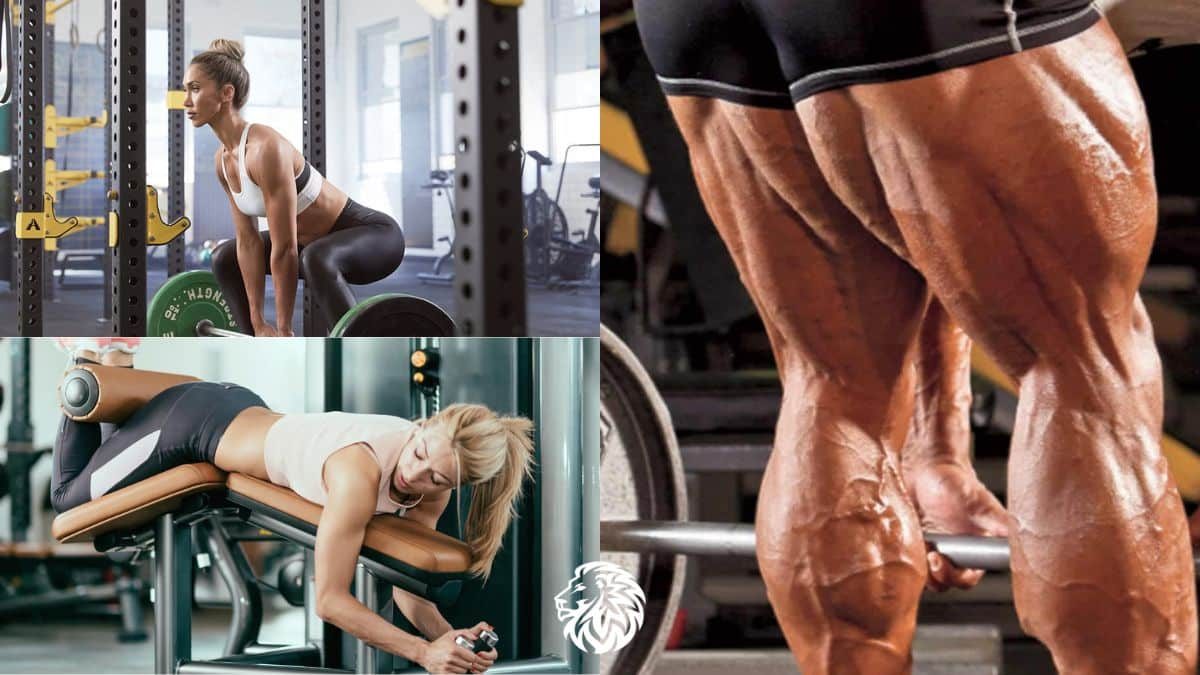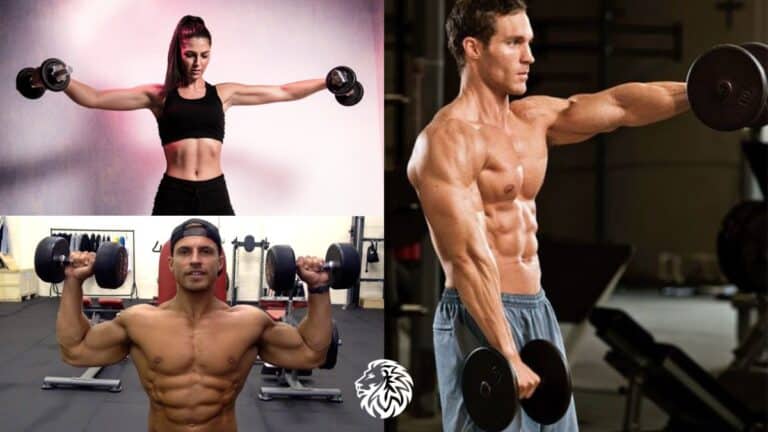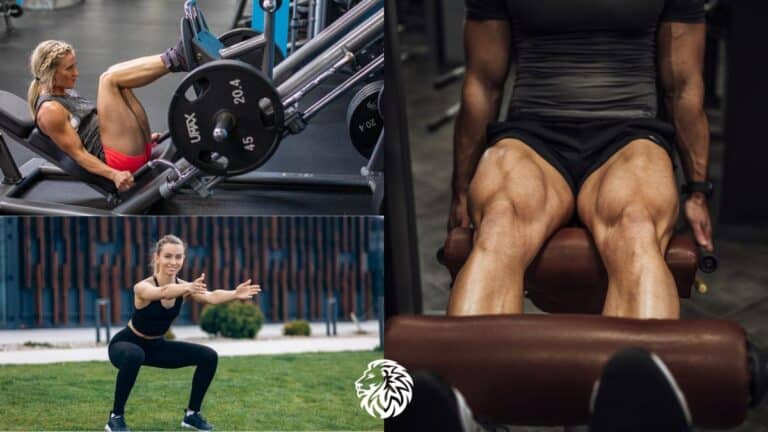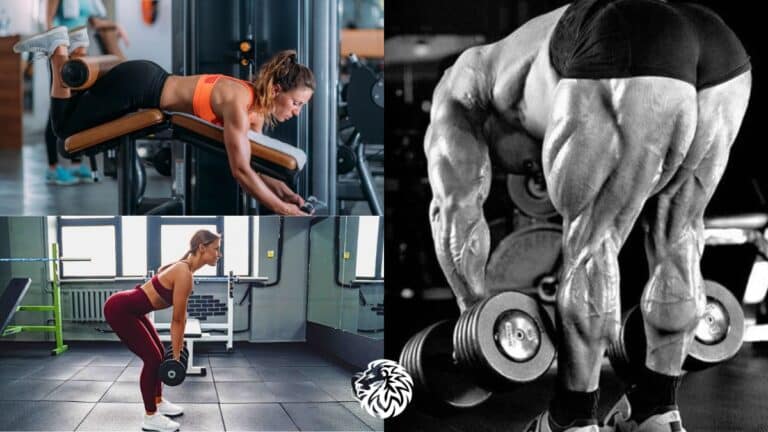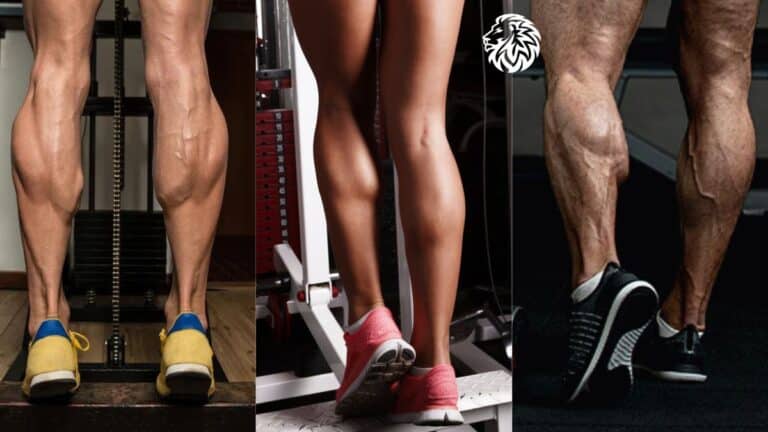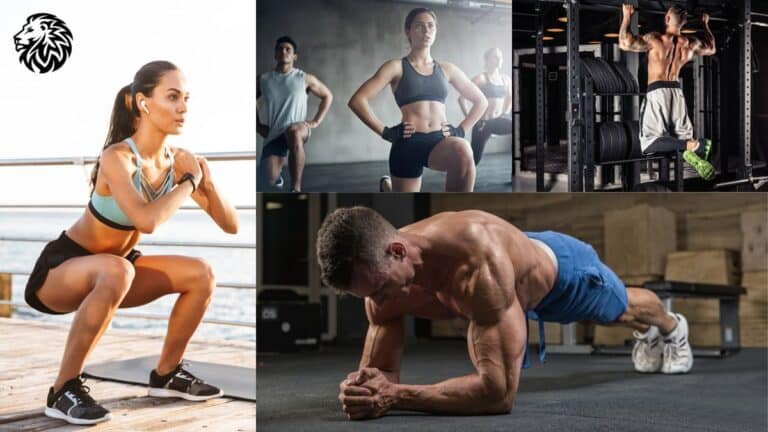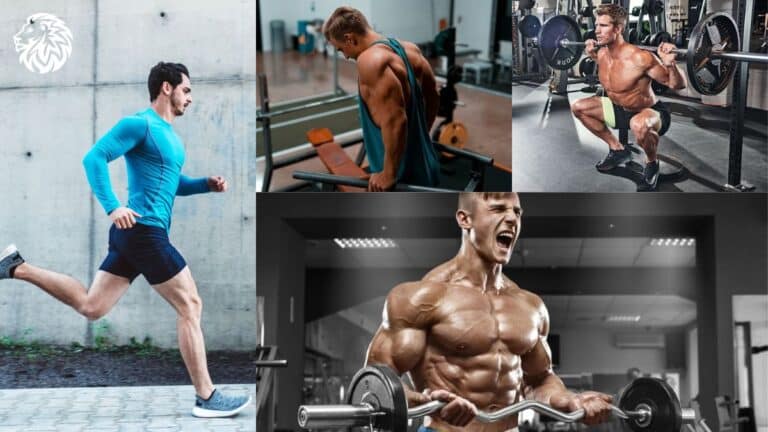The hamstrings are a crucial muscle group located at the back of the thigh, vital for everyday activities like walking, running, and jumping. Strong hamstrings not only enhance athletic performance but also play a significant role in preventing injuries. They work in tandem with the quadriceps to stabilize the knees and hips, ensuring proper posture and alignment. Strengthening the hamstrings can also alleviate lower back pain and improve overall leg strength, contributing to a more balanced and powerful lower body.
This article presents seven of the best hamstring exercises, each targeting this key muscle group in a unique way. From the classic Romanian Deadlift to the dynamic Kettlebell Swing, each exercise offers specific benefits and can be modified to suit various fitness levels. The Single-Leg Romanian Deadlift challenges balance and coordination, while the Lying Leg Curl focuses on isolated hamstring contraction. The Good Morning and Deadlift exercises are excellent for overall posterior chain development, and the Swiss Ball Hamstring Curl provides a challenging stability workout. Together, these exercises form a comprehensive hamstring strengthening program that can be incorporated into any fitness routine.
The Anatomy of The Hamstring Muscles
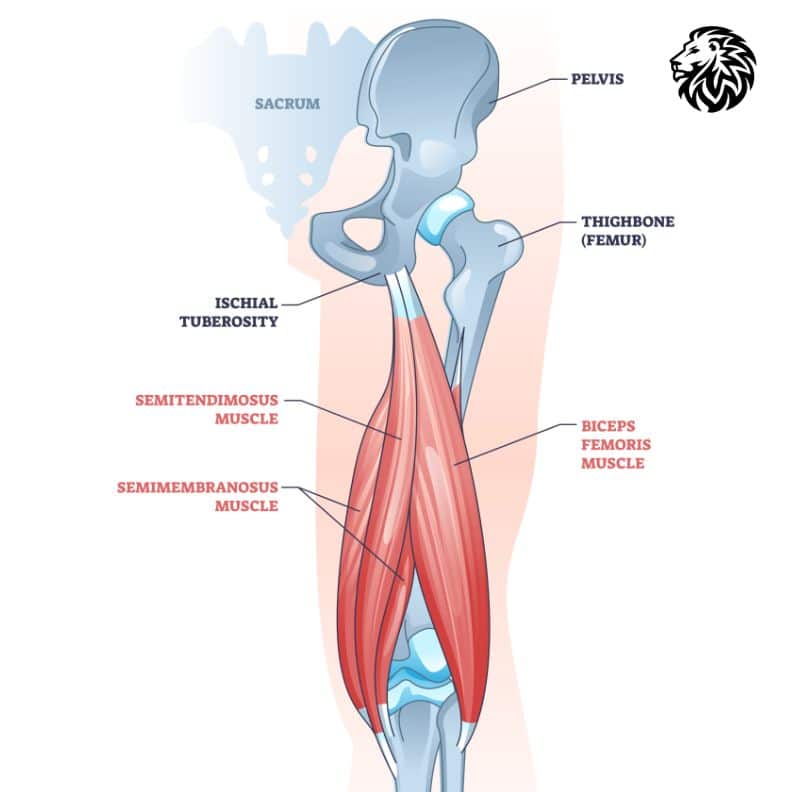
Understanding the anatomy of the hamstring muscles is crucial for comprehending their function and the importance of their strength and flexibility in physical activities. The hamstrings are a group of three muscles located at the back of the thigh. They include:
- Biceps Femoris: This is the most lateral of the hamstring muscles. It has two heads – the long head and the short head. The long head originates from the ischial tuberosity in the pelvis, while the short head originates from the femur. The biceps femoris is primarily involved in knee flexion and hip extension.
- Semitendinosus: This muscle also originates from the ischial tuberosity and runs medially down the back of the thigh. It inserts into the upper part of the tibia and plays a key role in knee flexion, hip extension, and internal rotation of the knee.
- Semimembranosus: Similar to the semitendinosus, it originates from the ischial tuberosity but has a wider, membranous insertion. It attaches to the medial condyle of the tibia. The semimembranosus assists in knee flexion, hip extension, and internal rotation of the hip.
Together, these muscles work to extend the hip when the body is upright and flex the knee. They also play a crucial role in maintaining proper posture, stabilizing the pelvis, and reducing the load on the lower back during activities such as running, jumping, and climbing.
Importance in Exercise and Injury Prevention
- Strength and Flexibility: Strong and flexible hamstrings are vital for athletes and non-athletes alike. They contribute to explosive movements, speed, and agility in sports. Flexibility in the hamstrings is essential for preventing strain on the lower back and reducing the risk of injuries.
- Balance and Posture: Strong hamstrings contribute to the balance between the front and back of the leg, crucial for proper body alignment and posture.
- Injury Prevention: Weak or tight hamstrings are a common cause of injuries, especially strains and tears. Regular exercise and stretching can help prevent these injuries.
Understanding the anatomy and function of the hamstring muscles highlights the importance of incorporating hamstring exercises into fitness routines. It also underscores the need for a balanced approach to leg workouts, ensuring that both the quadriceps and hamstrings are adequately strengthened to support overall leg function and health.
The 7 Best Hamstring Exercises
1. Romanian Deadlift
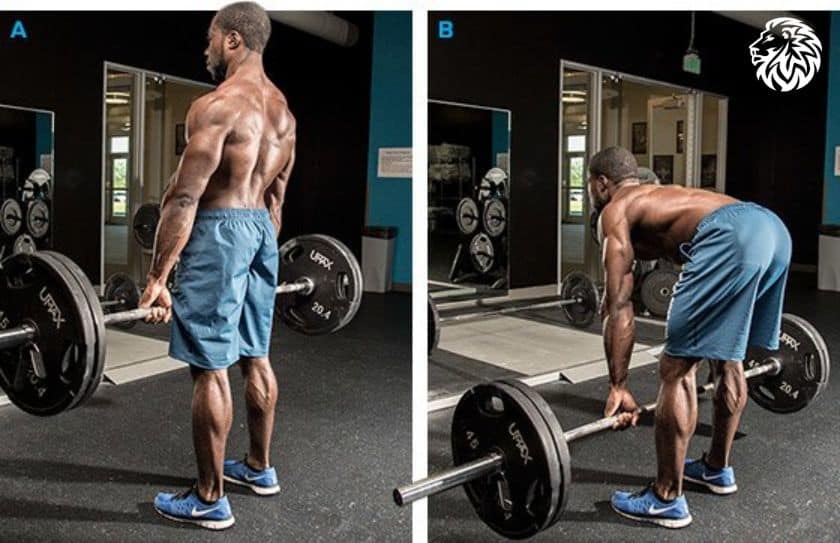
Description and Benefits
The Romanian Deadlift (RDL) is a fundamental exercise that primarily targets the hamstrings, glutes, and lower back. Unlike the conventional deadlift, the RDL focuses on hip hinge movement, which is essential for developing hamstring flexibility and strength. This exercise not only improves posterior chain strength but also enhances core stability, posture, and athletic performance. The RDL is especially beneficial for those looking to increase hamstring muscle mass and improve lower body functional movements.
Step-by-Step Guide
- Starting Position: Stand with your feet hip-width apart, holding a barbell in front of your thighs with an overhand grip. Keep your knees slightly bent.
- Hinge at the Hips: Slowly push your hips back while keeping your back straight. Allow the barbell to lower towards the ground, moving close to your legs.
- Lower the Barbell: Continue to lower the barbell until you feel a stretch in your hamstrings. Keep your spine neutral and shoulders back. The bar should reach around mid-shin level, depending on your flexibility.
- Return to Starting Position: Engage your hamstrings and glutes to return the barbell to the starting position, driving your hips forward.
- Repeat: Perform the desired number of repetitions while maintaining proper form.
Common Mistakes to Avoid
- Rounding the Back: One of the most common mistakes is rounding the lower back during the movement, which can lead to injury. Always keep your spine neutral.
- Locking the Knees: Completely locking out the knees puts unnecessary stress on the joints. Maintain a slight bend throughout the exercise.
- Overreaching: Avoid lowering the barbell too far, which can overstretch the hamstrings and compromise form. Go as low as your flexibility allows without rounding the back.
- Jerky Movements: The RDL should be performed in a controlled manner. Avoid jerky or rapid movements, especially when returning to the starting position.
- Improper Hip Hinge: Failing to hinge properly at the hips can reduce the effectiveness of the exercise and shift focus away from the hamstrings.
By avoiding these common mistakes and following the step-by-step guide, the Romanian Deadlift can be a highly effective exercise for building stronger and more resilient hamstrings.
2. Single-Leg Romanian Deadlift
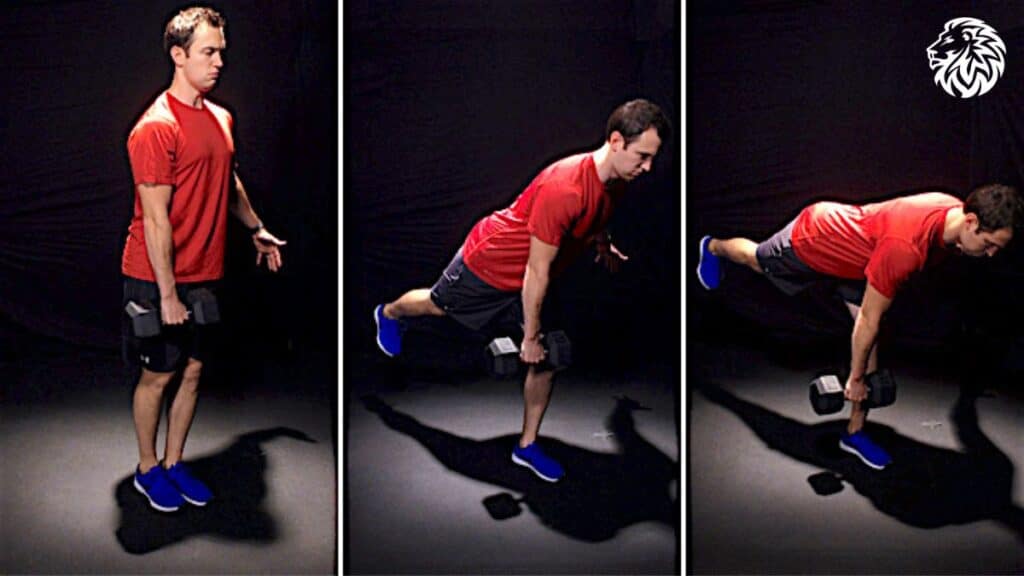
Description and Benefits
The Single-Leg Romanian Deadlift (SL RDL) is a variation of the traditional Romanian Deadlift, performed on one leg. This exercise targets the hamstrings, glutes, and lower back, with an added focus on balance and stability. It’s particularly effective for identifying and correcting muscle imbalances between legs. The unilateral nature of the exercise enhances core strength and improves coordination, making it a valuable addition to any fitness regimen.
Step-by-Step Guide
- Starting Position: Stand on one leg, with a slight bend in the standing knee. Hold a dumbbell in the hand opposite the standing leg (optional).
- Hinge at the Hips: Slowly hinge forward at the hips, keeping your back straight and extending your free leg behind you for balance. Lower your torso until it’s parallel with the floor, or as far as your flexibility allows.
- Maintain Alignment: Keep your hips square to the ground and your spine neutral. The dumbbell should lower directly below your shoulder.
- Return to Starting Position: Engage your hamstring and glute of the standing leg to rise back to the starting position.
- Repeat: Complete the desired number of repetitions before switching to the other leg.
Variations for Different Fitness Levels
- Beginners: Start with bodyweight only, focusing on balance and form. Use a wall or chair for support if needed.
- Intermediate: Add a light dumbbell or kettlebell to increase resistance. Focus on maintaining balance and controlled movements.
- Advanced: Increase the weight of the dumbbell or kettlebell. To further challenge balance and coordination, perform the exercise on an unstable surface like a foam pad.
- Additional Challenge: Integrate a pause at the bottom of the movement or increase the range of motion by standing on a step or platform.
By incorporating these variations, individuals at different fitness levels can effectively utilize the Single-Leg Romanian Deadlift to strengthen their hamstrings and improve overall balance and stability.
3. Lying Leg Curl
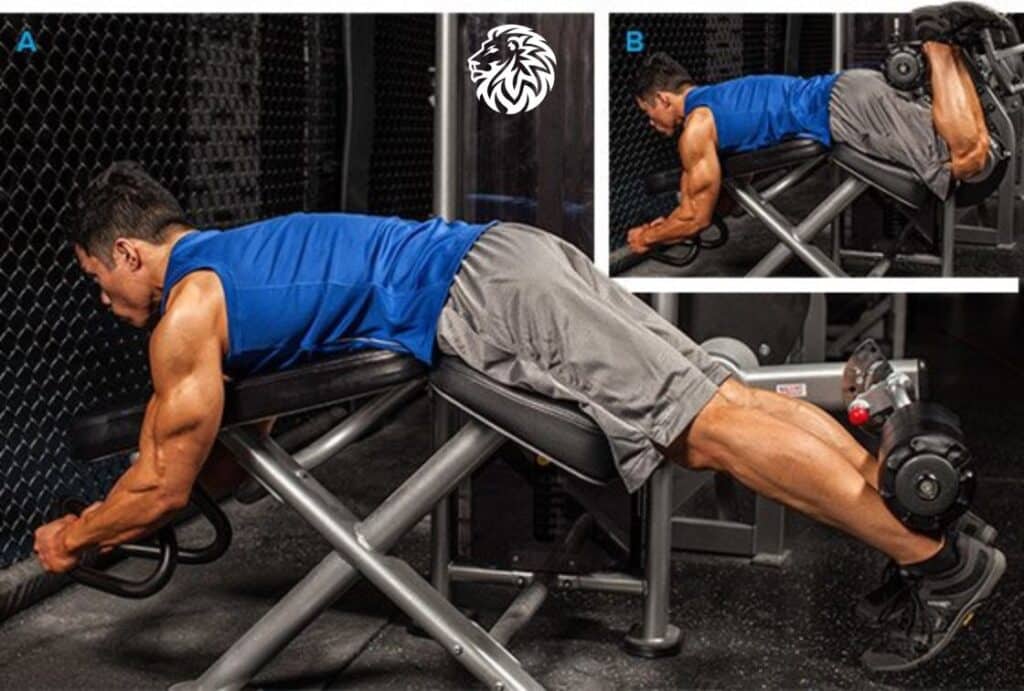
Description and Benefits
The Lying Leg Curl is a popular isolation exercise that specifically targets the hamstring muscles. Performed on a leg curl machine, it involves flexing the knees to bring the heels towards the glutes. This exercise is excellent for strengthening the hamstrings, enhancing knee joint stability, and improving overall leg muscle balance when combined with quadriceps-focused exercises. It’s also beneficial for athletes who require strong, explosive hamstrings for running and jumping activities.
How to Perform Effectively
- Machine Setup: Lie face down on the leg curl machine, with the pad of the lever on the back of your legs, just above your heels.
- Starting Position: Ensure your legs are fully extended, and grasp the machine’s handles for stability.
- Perform the Curl: Exhale and curl your legs up as far as possible without lifting your upper legs off the pad. Keep the motion smooth and controlled.
- Pause and Return: Hold the contracted position briefly, then slowly lower the weight back to the starting position while inhaling.
- Repeat: Perform the exercise for the desired number of repetitions, maintaining controlled movement throughout.
Tips for Maximizing Results
- Controlled Movements: Avoid jerky or rapid motions. A slow, controlled movement ensures maximum hamstring engagement.
- Full Range of Motion: Aim to use the full range of motion, curling the weight up as much as possible and then fully extending the legs.
- Avoid Overarching the Back: Keep your spine in a neutral position. Overarching can put unnecessary strain on your lower back.
- Focus on Hamstring Contraction: Concentrate on contracting the hamstrings throughout the exercise, especially at the peak of the movement.
- Progressive Overload: Gradually increase the weight or reps over time to continually challenge your hamstrings.
- Consistent Breathing: Breathe out on the curling movement and breathe in on the return. Proper breathing aids in muscle control and effectiveness.
- Warm-Up Properly: Engage in a thorough warm-up to prepare the hamstrings and reduce the risk of injury.
By following these guidelines, the Lying Leg Curl can effectively strengthen and build the hamstring muscles, contributing to a more balanced and powerful lower body.
4. Kettlebell Swing
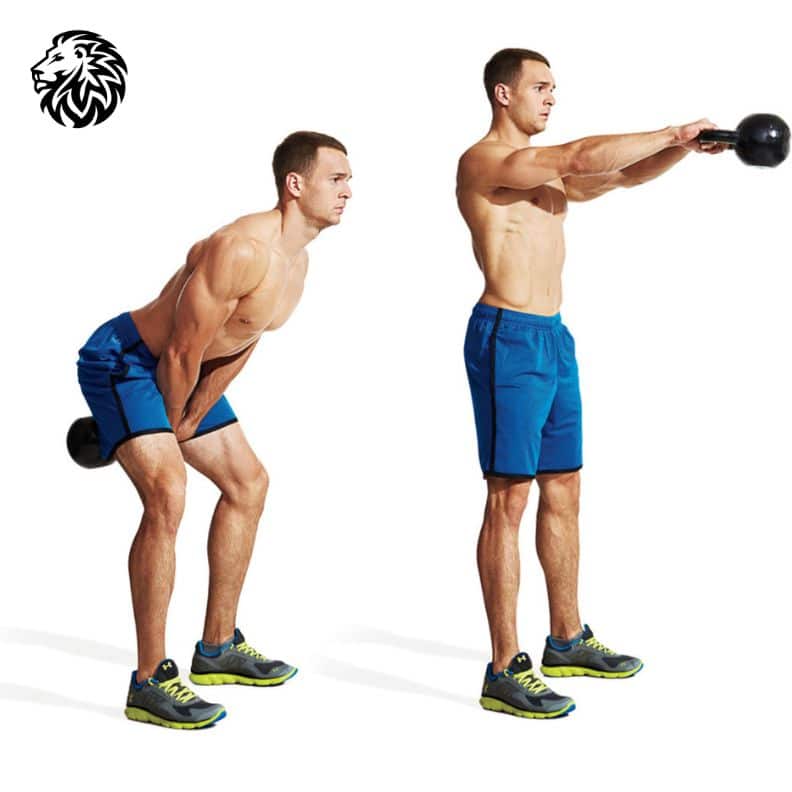
Description and Benefits
The Kettlebell Swing is a dynamic, compound exercise that targets multiple muscle groups, including the hamstrings, glutes, lower back, and core. It’s known for improving cardiovascular fitness, muscular endurance, and power. The explosive nature of the swing helps in developing hip hinge mechanics, which is crucial for many athletic movements. Additionally, it can aid in improving posture and burning calories, making it a versatile exercise for both strength and conditioning programs.
Detailed Instructions
- Starting Position: Stand with your feet slightly wider than hip-width apart, toes pointing forward or slightly out. Place a kettlebell on the ground between your feet.
- Grip the Kettlebell: Hinge at the hips and bend your knees slightly to reach down and grasp the kettlebell with both hands. Your back should be flat, and shoulders pulled back.
- Initiate the Swing: Lift the kettlebell off the ground and allow it to swing back between your legs.
- Drive Through Hips: Explosively drive your hips forward, straightening your legs and swinging the kettlebell up to chest height. Your arms should remain straight as you propel the kettlebell with your hips.
- Swing Movement: Let the kettlebell swing back down between your legs, hinging at the hips and slightly bending the knees as it goes back.
- Repeat: Continue the swinging motion, using the momentum and hip drive to keep the kettlebell moving fluidly.
Safety Tips
- Hip Drive, Not Arm Lift: The power of the swing comes from the hips, not the arms. The arms should only guide the kettlebell.
- Keep Your Back Straight: Maintain a neutral spine throughout the exercise to avoid strain on your lower back.
- Avoid Overextending: At the top of the swing, your body should form a straight line from head to toe. Avoid leaning back or overextending your hips.
- Stay Controlled: Control the kettlebell’s descent; don’t let it pull you backward.
- Use Proper Weight: Start with a weight that is manageable for you and progress as you get stronger and more comfortable with the form.
- Wear Proper Footwear: Shoes with good grip and support are essential for stability.
- Warm-Up: Engage in a dynamic warm-up to prepare your muscles, especially your hamstrings and glutes, before starting your kettlebell swings.
By adhering to these instructions and safety tips, the Kettlebell Swing can be a highly effective exercise for developing strength, power, and endurance in the hamstrings and other major muscle groups.
5. Good Morning Exercise
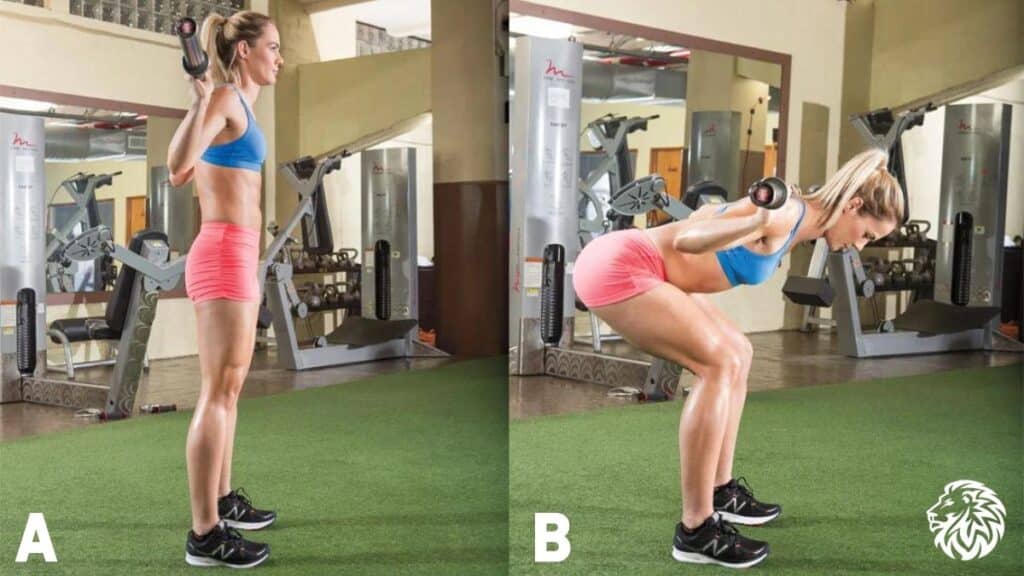
Description and Benefits
The Good Morning exercise is a strength training movement that primarily targets the hamstrings, glutes, and lower back. Named for its similarity to the motion of bowing forward in a “good morning” greeting, this exercise is excellent for improving posterior chain strength, flexibility, and hip mobility. It’s also beneficial for enhancing core stability and can help improve posture and lower back health when performed correctly.
Step-by-Step Technique
- Starting Position: Stand with your feet shoulder-width apart. Place a barbell across your shoulders, not your neck, gripping it slightly wider than shoulder-width. Keep your back straight, and knees slightly bent.
- Hinge at the Hips: Begin by pushing your hips back, hinging forward at the waist. Keep your back straight, chest up, and eyes looking forward.
- Lower Your Torso: Continue to hinge forward until your upper body is almost parallel to the floor, or as far as your hamstring flexibility allows. You should feel a stretch in your hamstrings.
- Return to Standing: Engage your hamstrings and glutes to return to the upright position, pushing your hips forward.
- Repeat: Perform the desired number of repetitions, maintaining a controlled movement throughout.
Alternative Versions
- Bodyweight Good Morning: Beginners can start with a bodyweight version, placing hands behind the head instead of using a barbell.
- Resistance Band Good Morning: Use a resistance band for a less intense version. Step on one end of the band and loop the other end behind your neck.
- Seated Good Morning: Performed by sitting on a bench, this variation focuses more directly on the lower back.
- Single-Leg Good Morning: Adds an element of balance and unilateral training, intensifying the focus on each leg.
- Dumbbell Good Morning: Hold a dumbbell at chest level for those who prefer not using a barbell.
Remember, the key to the Good Morning exercise is a controlled movement and proper form to avoid strain on the lower back. It’s essential to progress slowly, especially when adding weight, to ensure safety and effectiveness.
6. Swiss Ball Hamstring Curl
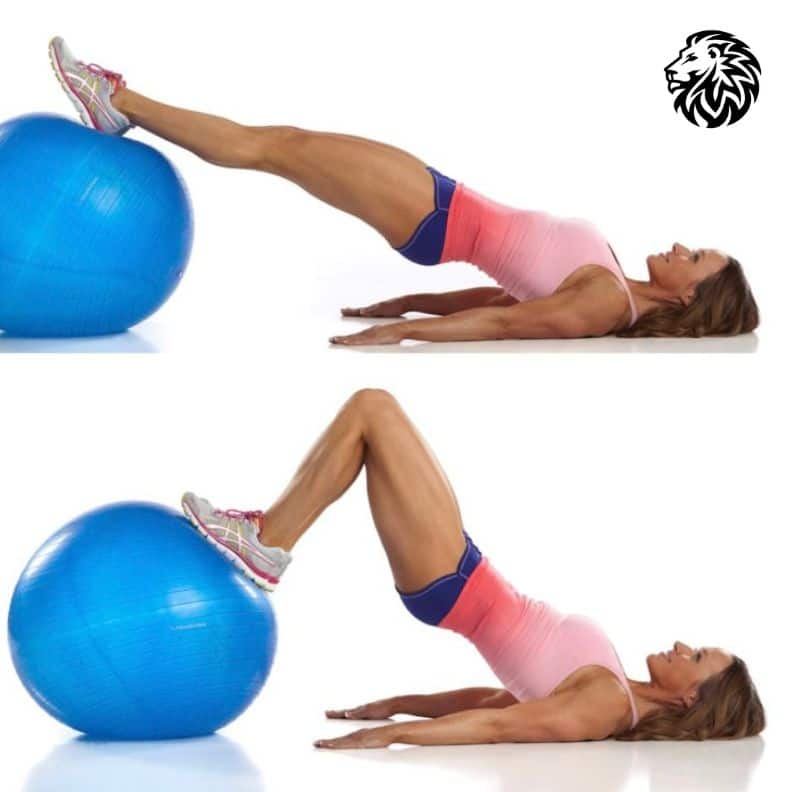
Description and Benefits
The Swiss Ball Hamstring Curl is a challenging exercise that utilizes a stability ball to target the hamstrings, glutes, and core muscles. This exercise is unique in its ability to engage the stabilizer muscles, improving overall balance and coordination. It’s particularly effective in enhancing hamstring strength and flexibility, while also working the core muscles for improved posture and lower back health.
Detailed Execution Method
- Starting Position: Lie flat on your back on the floor with your arms by your sides. Place your heels on top of a stability ball, legs straight.
- Lift Hips: Push your hips upward, forming a straight line from shoulders to heels.
- Curl the Ball: Bend your knees and use your feet to pull the ball towards your body, rolling the ball as close as possible to your glutes.
- Extend Legs: Slowly straighten your legs, rolling the ball back to the starting position while keeping your hips raised.
- Repeat: Continue for the desired number of repetitions, maintaining steady and controlled movements.
Adjustments for Beginners and Advanced Users
For Beginners:
- Shorten the Range of Motion: Start by only partially curling the ball towards your body until you build up strength and stability.
- Hip Bridge Hold: Practice holding the hip bridge position with your feet on the ball to build core and hamstring strength before attempting the full curl.
- Use a Larger Ball: A larger ball can be more stable and easier to control when starting out.
For Advanced Users:
- Single-Leg Curl: Perform the exercise with one leg for an added challenge, keeping the other leg raised in the air.
- Increase Repetitions or Speed: Add more reps or perform the curl at a faster pace to increase the intensity.
- Stability Ball Plank: Incorporate a plank hold with your feet on the ball between sets to further engage your core muscles.
Remember, the key to the Swiss Ball Hamstring Curl is control and stability. It’s important to progress at a pace that matches your strength and balance capabilities to maximize the benefits and minimize the risk of injury.
7. Deadlift
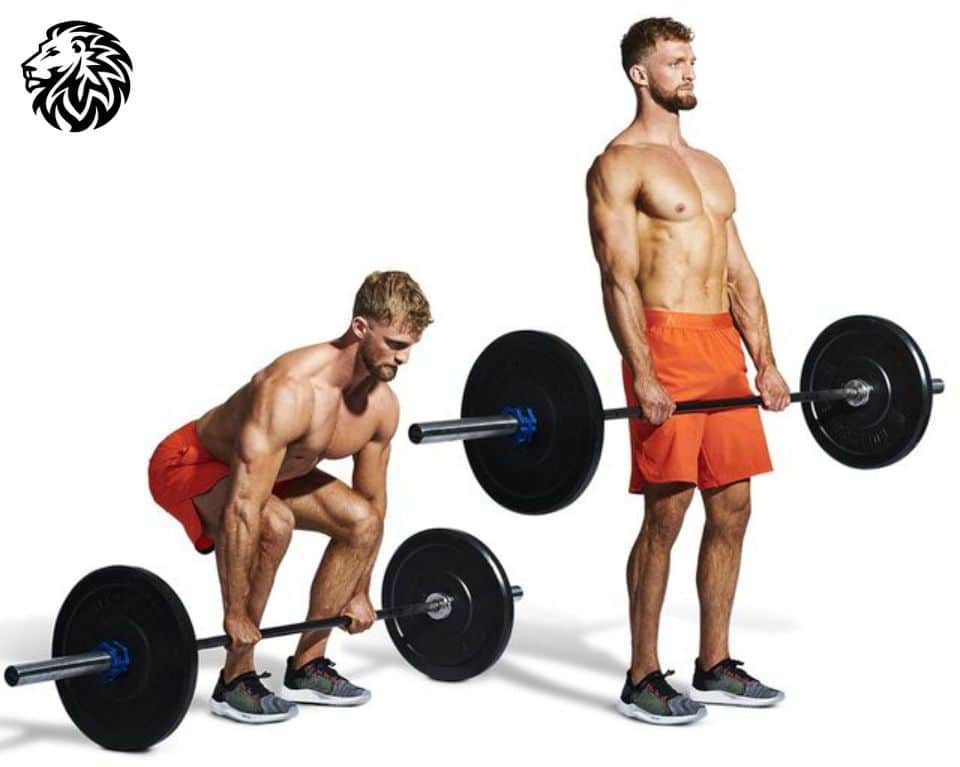
Description and Benefits
The Deadlift is a compound exercise that works multiple muscle groups, including the hamstrings, glutes, lower and upper back, hips, and core. It’s one of the most effective exercises for building overall strength and muscle mass. Deadlifts improve functional strength, aiding in everyday tasks and athletic performance. They also help in developing a strong, stable core and enhancing posture.
Proper Form and Execution
- Starting Position: Stand with your feet hip-width apart, toes pointing forward, and the barbell over the center of your feet.
- Grip the Bar: Bend at the hips and knees to reach down and grip the bar. Your grip should be just outside your legs, using an overhand grip or mixed grip (one hand over, one hand under).
- Lift the Bar: Keep your back straight, chest up, and gaze forward. Lift the bar by straightening your hips and knees, driving through the heels.
- Upward Movement: As you lift, keep the bar close to your body. Your shoulders should move up at the same rate as your hips.
- Lockout: Fully extend your hips and knees at the top of the lift. Squeeze your glutes at the top for a full hip extension.
- Lower the Bar: Reverse the movement by hinging at the hips and bending the knees, maintaining a straight back as you lower the bar to the ground.
Variations and Progressions
- Sumo Deadlift: Stand with a wider stance and your toes pointed out. This variation targets more of the glutes and inner thighs.
- Romanian Deadlift: Focuses more on the hamstrings, starting from a standing position and lowering the bar by hinging at the hips.
- Trap Bar Deadlift: Using a trap (hex) bar reduces strain on the lower back and places more emphasis on the legs.
- Deficit Deadlift: Stand on a raised platform. This increases the range of motion, intensifying the exercise.
- Stiff-Legged Deadlift: Similar to the Romanian Deadlift, but with less knee bend, placing more emphasis on the hamstrings.
- Rack Pulls: A deadlift variation that starts with the bar elevated on racks, focusing more on the lockout phase.
To safely and effectively perform the deadlift, it’s crucial to start with a weight that allows you to maintain proper form and gradually increase the load as you become more comfortable with the technique. Proper form is key to maximizing the benefits of the deadlift and minimizing the risk of injury.
Conclusion
Recap of Exercises
In this article, we explored seven effective hamstring exercises, each offering unique benefits to build strength, improve flexibility, and enhance overall lower body performance. The exercises included:
- Romanian Deadlift: Targets hamstrings, glutes, and lower back, emphasizing hip hinge mechanics.
- Single-Leg Romanian Deadlift: Focuses on unilateral hamstring strength and balance.
- Lying Leg Curl: An isolation exercise for concentrated hamstring engagement.
- Kettlebell Swing: A dynamic, full-body movement that strengthens the posterior chain and improves cardiovascular fitness.
- Good Morning Exercise: Strengthens the lower back, hamstrings, and glutes, enhancing core stability and posture.
- Swiss Ball Hamstring Curl: Utilizes a stability ball for hamstring and core strength, with an emphasis on balance.
- Deadlift: A compound lift that works multiple muscle groups, building overall strength and power.
Incorporating These Exercises into Your Routine
To effectively incorporate these exercises into your fitness routine, consider the following:
- Balance Your Training: Include these exercises in a well-rounded fitness regimen that also targets other muscle groups.
- Frequency: Aim to train your hamstrings 2-3 times per week, allowing adequate recovery time.
- Variety: Rotate through these exercises to target your hamstrings from different angles and prevent monotony.
- Progression: Start with lighter weights or fewer reps and gradually increase the intensity as your strength improves.
Final Tips and Advice
- Form is Key: Prioritize proper form over lifting heavier weights to prevent injuries.
- Warm-Up: Always start with a warm-up to prepare your muscles and joints for the exercises.
- Listen to Your Body: Pay attention to your body’s signals. If an exercise causes pain (other than normal muscle fatigue), stop and consult with a fitness professional.
- Consistency: Consistent training combined with proper nutrition and rest is crucial for muscle development and strength gains.
- Patience: Building strength and muscle takes time. Be patient and stay committed to your training regimen.
In conclusion, strengthening your hamstrings is essential for overall leg health, performance, and injury prevention. By incorporating these seven exercises into your routine, you can build stronger, more resilient hamstrings and achieve a more balanced and powerful lower body.
Frequently Asked Questions About Hamstring Exercises
- How often should I train my hamstrings?
- Aim for 2-3 times per week, ensuring you allow adequate recovery time between sessions.
- Can I do hamstring exercises if I have a history of knee or back pain?
- Yes, but it’s crucial to consult with a healthcare professional first. Proper form and appropriate exercise selection are key.
- What’s the difference between hamstring strength and flexibility, and how do these exercises help?
- Hamstring strength refers to the muscle’s ability to exert force, while flexibility is about the range of motion. These exercises improve both by strengthening the muscle and increasing its ability to stretch.
- How long does it take to see results from hamstring exercises?
- This varies per individual but typically, with consistent training, noticeable improvements can be seen within a few weeks to a couple of months.
- Should I focus more on weight or technique?
- Technique should always be the priority. Once you master the form, you can gradually increase the weight.
- Are these exercises suitable for beginners?
- Yes, but beginners should start with lighter weights or bodyweight and focus on mastering the form before progressing.
References and Further Reading
- TrainHeroic. (n.d.). Best hamstring exercises. TrainHeroic. Retrieved from https://www.trainheroic.com/blog/best-hamstring-exercises/
- Built With Science. (n.d.). Best compound hamstring exercises. Built With Science. Retrieved from https://builtwithscience.com/fitness-tips/best-compound-hamstring-exercises/
- American Council on Exercise. (2018, February). ACE-sponsored research: What is the best exercise for the hamstrings? ACE Fitness. Retrieved from https://www.acefitness.org/continuing-education/certified/february-2018/6896/ace-sponsored-research-what-is-the-best-exercise-for-the-hamstrings/
- Real Simple. (n.d.). Hamstring exercises and stretches. Real Simple. Retrieved from https://www.realsimple.com/health/fitness-exercise/workouts/hamstring-exercises-stretches
- Northeast Texas Community College. (n.d.). Hamstring exercises. NTCC. Retrieved from https://www.ntcc.edu/athletics/live-athlete/exercises/hamstring-exercises
